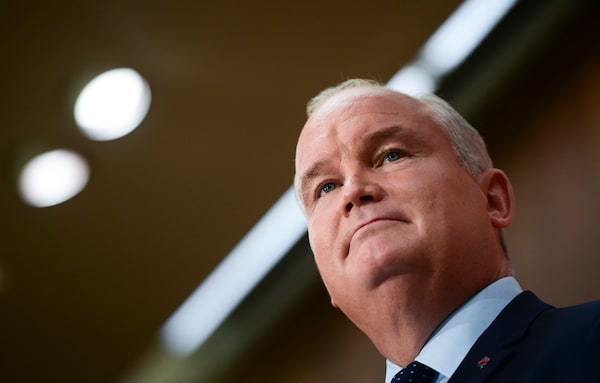
Erin O’Toole will go down in history as the first federal party leader to be sacked by his caucus under the provisions of the Reform Act.Sean Kilpatrick/The Canadian Press
Erin O’Toole may or may not be remembered 100 years from now, but he will go down in history as the first federal party leader to be sacked by his caucus under the provisions of the Reform Act, a law passed in 2015 to give MPs a pinch of power vis-à-vis their otherwise omnipotent party leaders.
It was an extraordinary demonstration of how consequential the Reform Act can be. But Mr. O’Toole’s defenestration also serves as a reminder of the adage about being careful what you wish for.
O’Toole pushed around caucus, as leaders always have. He didn’t count on caucus pushing back
There’s a word for a system that demands unanimous support for the leader, and it isn’t democracy
In Britain, which was Canada’s parliamentary template, the daily calls from within the U.K. Conservative Party for Prime Minister Boris Johnson to resign, or the threat that a party’s MPs will oust their leader, are routine. There is more of a balance of power between leader and MP. A leader really does rise out of the Commons, and a PM can be made, or unmade, by its members.
But in Canada, MPs are much less apt to publicly disagree with the party line or call for a leader to step down. Ottawa has a fetish for party discipline that is ruthlessly enforced. And that’s because, in any contest between party and MPs, the party – meaning the leader – has all the power.
The parties control who can run in an election. The leader’s office controls cabinet posts or shadow cabinet posts, jobs as parliamentary assistants and spots on important committees. They can also punish disloyal MPs with demotions to the back benches, and even boot them out of caucus and strip away their ability to ever run for the party again.
In other words, an MP’s political fortunes lie almost entirely in the hands of the leadership – especially on the government side, where the all-seeing and all-powerful Prime Minister’s Office has over the course of many decades neutralized the ability of the House of Commons to act as a check on the executive.
The Reform Act is an attempt to rebalance the scales. Above all, it gives MPs the power to call for a leadership review and oust the leader in a secret ballot. Canada’s parties long ago took this away from MPs and gave it to the grassroots membership, creating a more presidential prime ministership. The act also lets MPs decide whether a fellow member should be expelled from, or readmitted to, caucus. And it lets MPs elect their caucus chair, rather than having one imposed from above.
There’s a catch, though: By law, each party’s MPs must choose whether they want to give themselves these powers, by taking a secret vote on each of the provisions after each general election.
The Conservatives were the only party to adopt all the measures after the 2021 election; the Liberals, NDP and Bloc Québécois adopted none of them.
It is probably no coincidence that Tory MPs, having just suffered their second election disappointment in a row, were the first in the short history of the Reform Act to give themselves the tools to remove their leader.
And there is some irony in the fact the Reform Act, tabled and championed by Michael Chong, a progressive Conservative MP, has now been used to oust a Conservative leader of the same bent, making way for a likely shift to the right.
That outcome is also a reminder that it will take more than the Reform Act to fix what ails politics in Ottawa.
The Conservatives, for instance, choose leaders through votes of party members – a relatively small group of partisans willing to pay a membership fee. The tiny percentage of Canadians who do so are often committed to narrow causes; the 174,000 people who decided the Conservative leadership race in 2020 were not representative of the millions of people open to voting Conservative. Witness Mr. O’Toole’s painful journey, running right to win the leadership but then having to backpedal to the centre in the election.
An internal Conservative review has suggested the party broaden the base of those choosing the leader by making memberships free. Others have talked about a primary system, potentially opening the leadership vote to millions.
The goal is to prevent both leadership races and candidate nomination contests from being captured by narrow interests, as the race to become Mr. O’Toole’s successor seems destined to be.
The Reform Act has shown it can give MPs real power. For the Conservatives, the next challenge is reforming how they choose candidates and leaders.
Keep your Opinions sharp and informed. Get the Opinion newsletter. Sign up today.